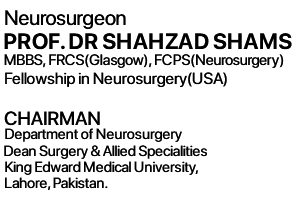What to Do in Case of Brain Injury or Head Injury or Head Trauma or Cranial Trauma?
Prof. Shahzad Shams presently works as Head and Professor of Neurosurgery Department at Lahore General Hospital, LGH, Lahore.
Most of the General Practitioners (G.P’s) have a fear to receive and manage head injured patients.
I am sure following points will be of great help in the management of these patients.
History
Following points are important in history which indicate the severity of trauma:
- Vomiting
- Loss of consciousness.
- Lucid interval
- Fits
- Bleeding from nose and ear
Examination
1. General Examination:
- Clear and maintain airway.
- Check for wounds and perform pressure bandage.
- Quick limb and systemic examination
2. Initial Neurological Examination:
- Categorize into mild, moderate and severe
- Pupillary response to light and pupil difference.
- Motor power
Investigations
Advise Skull X – rays Anteroposterior and lateral view and look for linear fractures and fractures with double density.
On Receiving Patient at Your Clinic
Most of the time General practitioners refuse to take head injured patients and ask attendants to take them to a teaching hospital. I would suggest being G.P you have an important role to play. As soon as you receive the patients immediately categorize into one of the following three states to decide in which category patient falls:
- Mild
- Moderate
- Severe
Once you have clearly placed the patient in one of the above categories then proceed for management as follows:
Mild Category
(80 % of all head injured patients)
Definition: Patient is awake and orientated.
Management:
Mild category to be treated by you and then discharged with a warning sheet as given below:
Moderate Category
(10 % of all head injured patients)
Definition: Patient is confused or somnolent but is able to follow simple commands.
Management:
- Treat these patient at your clinic.
- But keep under observation and perform frequent neurological exams.
- If any deterioration occurs refer to teaching hospital.
- If improves (90 %) discharge when stable with a warning sheet as given below.
Severe Category
(10 % of all head injured patients )
Definition: Patient is unable to follow a simple command because of impaired conscious level.
Management:
Manage as for severely injured patient with initial resuscitation:
- Secure airway.
- Maintain I/V line.
- Stop bleeding by bandage.
- Apply cervical collar.
- Start I/VMannitol 1gm/kg body weight.
- Pass Foly’s cathether.
- Then place in left lateral position.
- Then shift to a teaching hospital as you have done a good job.
Warning Sheet to Be Given to Patient at Discharge
Please contact immediately if following symptoms are observed
- Deteriorating conscious level.
- Development of weakness of limbs
- Persistent vomiting.
- Epileptic fit.
- High grade fever with neck stiffness.






